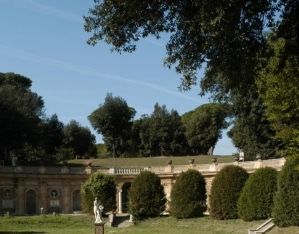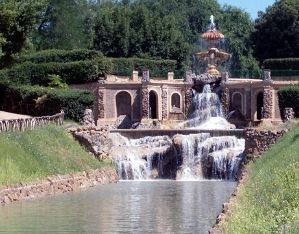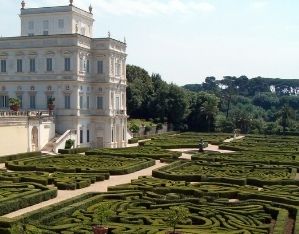Also known as “Bel Respiro” for the healthy air at its elevated position, the garden offers stunning views out over the city and the dome of St. Peter’s. Once a backdrop to the family’s power and the intrigues of the Pope’s sister-in-law, the infamous Olimpia Maidalchini, it is today the realm of nature lovers and joggers, while the building is used as the offices of the Italian Prime Minister.
Cardinal Camillo Pamphilj, nephew to Pope Innocent X who was elected to the papacy in 1644, converted this rustic family property into an emblem of his prestige. Later expanded to a total area of 184 hectares, making it the largest park in Rome, it features refined formal gardens, complex architectural elements, and valleys so wild it feels like deer and roe deer may be lurking just out of sight. The Alessandro Algardi-designed “Casino nobile”, its elevations adorned with statues, busts and reliefs, is an expression of 17th-century classicism; it opens onto an elaborate parterre, and is backed by a majestic holm oak wood. Lower down, the Nymphaeum of Venus is an illustration of Virgil’s saying “Amor vincit omnia, et nos cedamus amori”, a reference to the Cardinal’s decision to turn his back on the church and marry Olimpia Aldobrandini. Buildings of various ages and types are dotted around the park’s pine stands and extensive meadows, including a number of cast iron and glass greenhouses that house precious plants. A copy of the Fountain of the Snail sits in the middle of a large lawn. The original, by Gian Lorenzo Bernini, is at the Doria Pamphilj Gallery. After it was enlarged and embellished in the 18th century to adapt to the newly-popular “English-style”, in 1849 supporters of the Roman Republic and the French army fought in the park, causing significant damage to buildings and trees. The park has been open to the public since 1960.
Highlights

The Theatre Garden
Conceived as an open-air museum, the surrounding exedra is adorned with ancient and 17th-century reliefs illustrating man’s path to salvation. As well as being planted with many rare and exotic trees, the 19th-century Putto Fountain features two overlapping pools and is adorned with numerous statues of nymphs and satyrs.

The Lake Canal
In the 18th century, the 17th-century Lily Fountain became the starting point for a spectacular water feature conceived by Giovanni Antinori, complete with sprinkles, small waterfalls and still basins, ultimately ending in a lake. Not far from here, early in the 19th century groundbreaking gardener Francesco Bettini planned an innovative agronomic garden. Unfortunately, no trace of it remains.

The Secret Garden
Overlooking a large parterre, from its elevated position the Casino Nobile offers fine views over the park. Among its elaborate boxwood volutes, the family’s heraldic lilies are on show in flowerbeds, interspersed with numerous vases of citrus trees. Uphill from the Casino, a beautiful fishpond is surrounded by majestic specimens of Taxodium distichum, a rare conifer otherwise known as the bald cypress.
 Villa Doria Pamphilj
Contacts
Villa Doria Pamphilj
Contacts
Contacts
Telephone:+39 060608
Other contacts::General information on offices and services: +39 06 6710 3238/3887
Address
Viale Vittoria Nenni
00164, Roma (RM)
 Villa Doria Pamphilj
Opening times and prices
Villa Doria Pamphilj
Opening times and prices
Opening hours
Park opening hours:
- October – February: 7 a.m. – 6 p.m.
- March and September: 7 a.m. – 8 p.m.
- April – August: 7 a.m. – 9 p.m.
Pricing
Entrance to the Villa Pamphilj Gardens is always free.
 Villa Doria Pamphilj
How to get there
Villa Doria Pamphilj
How to get there
Address
Viale Vittoria Nenni
00164, Roma (RM)
Latitude: 41.90131
Longitude: 12.4199587
How to arrive by bus
- Bus no. 710 and 870 (via Vitellia, via di Porta S.Pancrazio)
- Bus no. 31, 33, 180, 791 (Leone XIII Street)
- Bus no. 984 (Via Aurelia Antica and Via Leone XIII)
- Bus no. 982 (Via Vitellia, Via Leone XIII)
How to arrive on foot
Inputs:
- Via Aurelia Antica
- Largo Martin Luther King
- Via Vitellia
- Via Leone XIII (Olimpica)
- Largo 3 June 1849
- Via della Nocetta
- San Pancrazio Square
 Villa Doria Pamphilj
Services/Accessibility
Villa Doria Pamphilj
Services/Accessibility
Services
The bistro with cafeteria and lounge bar at Villa Pamphilj offers breakfast, lunch, aperitifs, dinner and brunch. Entrance Via Vitellia 102. Info and reservations on Vivi Bistrot .
The dog area is located near the entrance of Via Leone XIII, 75 (indicated by appropriate signs).
Children's play areas are located at:
- Viale S. Lagerlöf (nearest entrances: via Leone XIII 30 or via Vitellia 102)
- Viale Otto Marzo (nearest entrance: via Vitellia 76)
- Piazzale del Casale di Giovio (nearest entrances: via Leone XIII 75 or via Aurelia Antica 327)
 Villa Doria Pamphilj
Private events
Villa Doria Pamphilj
Private events
 Villa Doria Pamphilj
Itineraries
Villa Doria Pamphilj
Itineraries
You could find the garden in these itineraries
 Favorite saving result
Favorite saving result
 Warning!
Warning!
You've have to sign up or sign in to add this element to your favorites.
